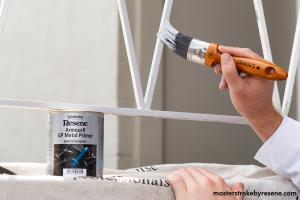Ultimate Guide on How to Paint Metal Surfaces: Techniques & Best Paints

-
Quick Links:
- 1. Introduction
- 2. Why Paint Metal Surfaces?
- 3. Types of Metal Surfaces
- 4. Preparation: The Key to Success
- 5. Best Paints for Metal Surfaces
- 6. Application Techniques
- 7. Maintenance of Painted Metal Surfaces
- 8. Case Studies
- 9. Expert Insights
- 10. FAQs
1. Introduction
Painting metal surfaces can be a daunting task, but it is also an opportunity to transform an object, enhance its life, and improve its aesthetic appeal. Whether it's a fence, furniture, or machinery, understanding the right techniques and materials is crucial for achieving a long-lasting finish. This guide will explore everything you need to know about painting metal surfaces, including the best types of paint, preparation steps, and application techniques.
2. Why Paint Metal Surfaces?
Painting metal surfaces serves multiple purposes:
- Rust Prevention: Metal surfaces are prone to rusting, especially when exposed to moisture. Paint acts as a barrier against the elements.
- Improved Aesthetic: A fresh coat of paint can significantly enhance the appearance of metal items, making them look new and vibrant.
- Durability: Quality paints can increase the lifespan of metal surfaces, protecting them from scratches, dents, and corrosion.
- Customization: Painting allows for personalization of metal items, enabling you to match colors with your decor or brand.
3. Types of Metal Surfaces
Understanding the type of metal you are working with is essential as different metals react differently to paint. Here are some common types:
- Steel: Commonly used in construction and furniture, it is notorious for rusting.
- Aluminum: Lightweight and resistant to corrosion but requires special preparation.
- Iron: Heavy and extremely prone to rust; often requires a primer.
- Galvanized Steel: Coated with zinc to prevent rust but can be tricky to paint without proper prep.
4. Preparation: The Key to Success
Preparation is arguably the most critical step when painting metal. Here’s a step-by-step guide:
4.1 Cleaning the Surface
Start by cleaning the metal surface thoroughly to remove any dirt, grease, or old paint. Use a mixture of soap and water or a degreaser to ensure a clean base.
4.2 Removing Rust
If there are rust spots, use sandpaper or a wire brush to remove them. For larger areas, consider using a rust remover or converter.
4.3 Sanding
Sanding the surface creates a texture that helps paint adhere better. Use fine-grit sandpaper for best results.
4.4 Priming
Apply a quality primer suitable for metal surfaces. This step is vital for creating a barrier and improving paint adhesion.
5. Best Paints for Metal Surfaces
Choosing the right paint can make or break your project. Below are some of the best types of paint for metal surfaces:
- Oil-Based Paint: Provides a durable finish and better adhesion, ideal for outdoor metal surfaces.
- Water-Based Paint: Easier to clean up and dries faster. Look for formulations specifically made for metal.
- Epoxy Paint: Extremely durable and resistant to chemicals, perfect for industrial applications.
- Spray Paint: Convenient for small projects, ensure to choose one designed for metal surfaces.
6. Application Techniques
Once you've prepared the surface and selected your paint, it's time to apply it. Here are some techniques:
6.1 Brush Application
Use a high-quality brush for detailed work, ensuring even coverage. Avoid over-brushing to prevent streaks.
6.2 Roller Application
A roller can cover larger areas more quickly, but be sure to use one that is suitable for smooth surfaces.
6.3 Spray Application
Using spray paint allows for an even finish, but requires practice to avoid drips. Maintain a steady hand and appropriate distance.
7. Maintenance of Painted Metal Surfaces
To ensure longevity, regular maintenance is key:
- Inspect for chips or rust regularly.
- Clean the surface to remove dirt and grime.
- Touch up any areas that show signs of wear.
8. Case Studies
Here are a couple of successful metal painting projects:
8.1 Community Park Benches
A local community revived its park benches by using high-quality rust-resistant paint, resulting in a 5-year life extension.
8.2 Industrial Machinery
A factory applied epoxy paint to its machinery, leading to a significant decrease in rust and maintenance costs over three years.
9. Expert Insights
We consulted with professional painters and here are their top tips:
- Always test a small area first.
- Choose the right paint based on the metal type.
- Don’t skip the primer; it’s essential for durability.
10. FAQs
1. Can I paint over rust?
It's not recommended, but if you must, use a rust-inhibiting primer before painting.
2. How long should I wait between coats?
Typically, 1-4 hours, depending on the paint type and environmental conditions.
3. What is the best temperature for painting metal?
The ideal range is between 50°F and 85°F (10°C and 30°C).
4. Do I need a clear coat after painting?
For added protection, especially for exterior items, a clear coat is beneficial.
5. How do I remove paint from metal?
Use a chemical stripper, heat gun, or sandblasting for effective removal.
6. Can I use exterior paint on indoor metal?
Yes, but exterior paints may have stronger odors and longer drying times.
7. What should I do if paint bubbles on metal?
Remove the affected area and reapply after proper preparation.
8. Is spray paint better than brush paint for metal?
Spray paint can provide a smoother finish, but brush paint allows for more control.
9. How do I ensure even paint coverage?
Apply thin, even coats and allow adequate drying time between layers.
10. Can I paint galvanized metal?
Yes, but you must first clean and prime it with a suitable primer.